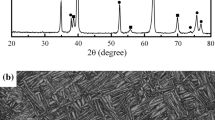Abstract
The low tribo-characteristics of Ti6Al4V (Ti64) have delimited its range of applicability. To elucidate the underlying mechanism, the friction and wear behavior of Ti64 at elevated pin speeds (200 rpm, 300 rpm and 400 rpm), constant load (50 N) and temperature (ambient) conditions were initially evaluated. The wear, coefficient of friction and frictional force characteristics of the material were identified to follow incessant unsteady transitions, during test run. The pin speed of 300 rpm marked the highest wear, governed by the frictional heating, asperity flattening, centrifugal forced clearance (of the wear track) and third-body abrasion-assisted delamination. The reduced wear trend at 200 rpm and 400 rpm could be attributed to the protective coatings formed by tribo-oxidation and mechanically mixed layer, respectively. Further, the electrical discharge machined Ti64 samples were developed and subjected to friction and wear analyses at varying loads of 50 N and 100 N. In contrast, at similar testing conditions (load 50 N, speed 200 rpm, temperature ambient, sliding distance 1000 m), the electrical discharge machined Ti64 (with a peak wear value of 220 μm) showed enhanced tribo-characteristics compared to that of bare Ti64 (with a peak wear value of 370 μm). The improved tribo-behavior of the former was due to the presence of hard, fine-grained and non-etchable recast layer, which got spalled off at an increased load of 100 N.












Similar content being viewed by others
References
Collings E W, Metals Park Ohio 3 (1984).
Mao Y S, Wang L, Chen K M, Wang S Q, and Cui X H, Wear 297 (2013) 1032. https://doi.org/10.1016/j.wear.2012.11.063.
Ganesh B K C, Ramanaih N, and Rao P C, Trans Indian Inst Metals 65 (2012) 425. https://doi.org/10.1007/s12666-012-0147-4.
Bird K W, Non-Aerosp Appl Titan (1998) 245.
Chiou S T, Tsai H L, and Lee W S, Mater Trans 48 (2007) 2525. https://doi.org/10.2320/matertrans.MRA2007607.
Jeong D, Kwon Y, Goto M, and Kim S, Metals Mater Int 22 (2016) 747. https://doi.org/10.1007/s12540-016-6075-9.
Budinski K G, Wear 151 (1991) 203. https://doi.org/10.1016/0043-1648(91)90249-t.
Wiklund U and Hutchings I M, Wear 251 (2001) 1034.
Yerramareddy S and Bahadur S, Wear 157 (1992) 245. https://doi.org/10.1016/0043-1648(92)90065-g.
Hadke S, Khatirkar R K, Shekhawat S K, Jain S, and Sapate S G, J Mater Eng Perform 24 (2015) 3969. https://doi.org/10.1007/s11665-015-1667-y.
Pottirayil A and Kailas S V, J Tribol 139 (2017) 021603. https://doi.org/10.1115/1.4033363.
Dong H, Bloyce A, Morton P H, and Bell T, Surf Eng Improve Tribol Perform Ti–6Al–4 V 13 (1997) 402. https://doi.org/10.1179/sur.1997.13.5.402.
Liu K K and Hill M R, Tribol Int 42 (2009) 1250. https://doi.org/10.1016/j.triboint.2009.04.005.
Namjoshi S A, Jain V K, and Mall S, J Eng Mater Technol 124 (2002) 222. https://doi.org/10.1115/1.1448323.
Shashkov D P, Treatment 43 (2001) 233. https://doi.org/10.1023/A:1012374029482.
Chen K M et al., Mater Des (2015). https://doi.org/10.1016/j.matdes.2014.09.016.
Li X X, Zhou Y, Li Y X, Ji X L, and Wang S Q, Metall Mater Trans A 46 (2015) 4360. https://doi.org/10.1007/s11661-015-3019-9.
Nemat-Nasser S, Guo W G, Nesterenko V F, Indrakanti S S, and Gu Y B, Mech Mater 33 (2001) 425. https://doi.org/10.1016/S0167-6636(01)00063-1.
Me-Bar Y and Shechtman D, Mater Sci Eng 58 (1983) 181. https://doi.org/10.1016/0025-5416(83)90044-7.
Straffelini G and Molinari A, Wear 236 (1999) 328. https://doi.org/10.1016/s0043-1648(99)00292-6.
Guleryuz H and Cimenoglu H, Surf Coat Technol 192 (2005) 164. https://doi.org/10.1016/j.surfcoat.2004.05.018.
Borgioli F, Galvanetto E, Iozzelli F, and Pradelli G, Mater Lett 59 (2005) 2159. https://doi.org/10.1016/j.matlet.2005.02.054.
Kuriachen B, Lijesh K P, and Kuppan P, Trans Indian Inst Metals 1 (2018) 10. https://doi.org/10.1007/s12666-017-1267-7.
Lim L C, Lee L C, Wong Y S, and Lu H H, Mater Sci Technol 7 (1991) 239. https://doi.org/10.1179/mst.1991.7.3.239.
Ekmekci B, Appl Surf Sci 253 (2007) 9234. https://doi.org/10.1016/j.apsusc.2007.05.078.
Ramasawmy H, Blunt L, and Rajurkar K P, Precis Eng 29 (2005) 479. https://doi.org/10.1016/j.precisioneng.2005.02.001.
Stráský J, Janeček M, Harcuba P, Bukovina M, and Wagner L, J Mech Behav Biomed 4 (2011) 1955. https://doi.org/10.1016/j.jmbbm.2011.06.012.
Stráský J, Havlíková J, Bačáková L, Harcuba P, Mhaede M and Janeček M, Appl Surf Sci 281 (2013) 73. https://doi.org/10.1016/j.apsusc.2013.02.053.
Kremer D, Lhiaubet C, and Moisan A, CIRP Ann 40 (1991) 211. https://doi.org/10.1016/s0007-8506(07)61970-2.
Dixit T, Singh I, and Prasad K E, Wear 420 (2019) 207.
Hu M et al., Ti–6Al–4V. Wear 376 (2017) 134.
Olvera D et al., Mach Sci Technol 16 (2012) 173.
Sharma M D and Sehgal R, Ind Lubr Tribol 66 (2014) 174.
Biswas S K, Wear of Metals A material approach. Wear, Materials, Mechanisms and Practices, Wiley, New York (2006).
Wang L, Wang L, Li X X, Zhou Y, Zhang Q Y, Chen K M and Wang S Q, Relat Count Mater Stab Tribo-oxide Layer Wear Behav, 91 (2015). https://doi.org/10.1016/j.triboint.2015.01.028.
Tomlinson W J and Adkin J R, Surf Eng 8 (1992) 283. https://doi.org/10.1179/sur.1992.8.4.283.
Acknowledgements
The authors extend their humble obligations to the Science and Engineering Research Board (SERB), Department of Science and Technology (DST), Government of India, for the research grand sanctioned for the project (Ref. No. ECR/2016/001929) through the aid of which this initiative was undertaken.
Author information
Authors and Affiliations
Corresponding author
Additional information
Publisher's Note
Springer Nature remains neutral with regard to jurisdictional claims in published maps and institutional affiliations.
Rights and permissions
About this article
Cite this article
Philip, J.T., Kumar, D., Mathew, J. et al. Wear Characteristic Evaluation of Electrical Discharge Machined Ti6Al4V Surfaces at Dry Sliding Conditions. Trans Indian Inst Met 72, 2839–2849 (2019). https://doi.org/10.1007/s12666-019-01760-7
Received:
Accepted:
Published:
Issue Date:
DOI: https://doi.org/10.1007/s12666-019-01760-7




